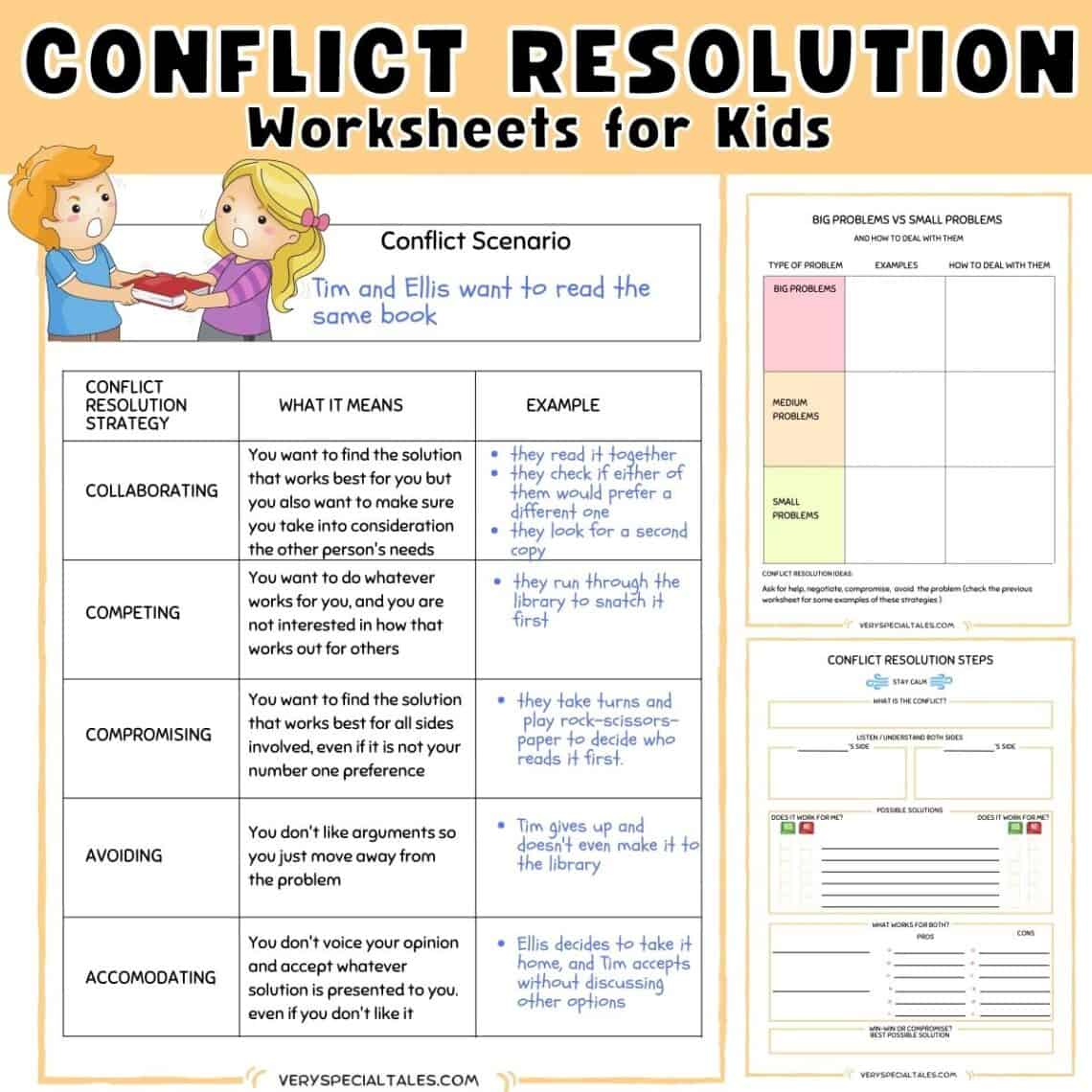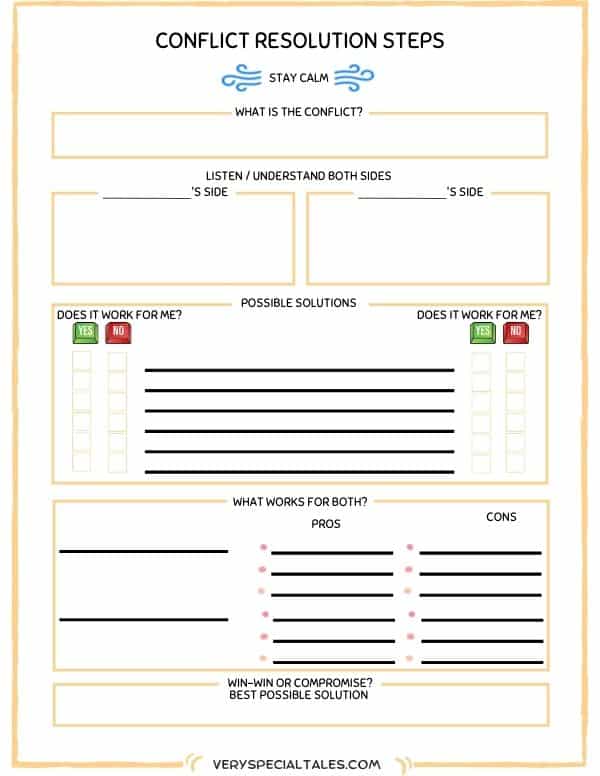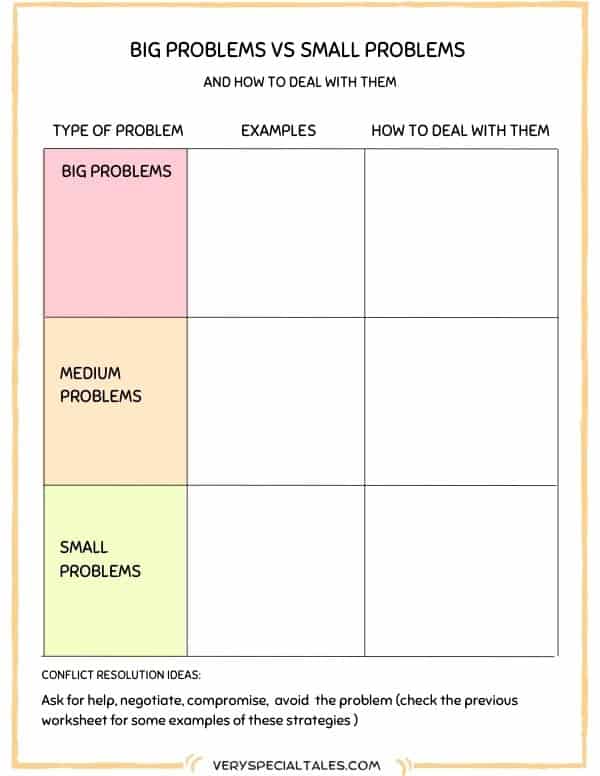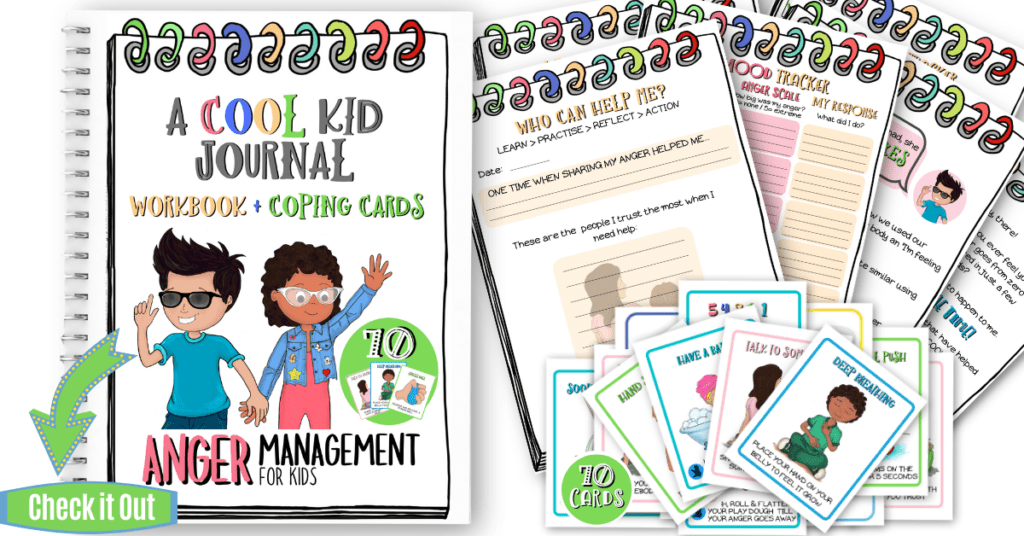
20 Fun Conflict Resolution Activities for Kids (Printable PDF): Worksheets, Games and Activities
Conflict resolution activities for kids: In this post, we will explore different strategies to help kids deal with conflict. We will also list fun and easy activities that you can add to your conflict resolution lessons or use at home with your kids. And, at the end of the post, you will be able to download some conflict-resolution worksheets.
We all go through conflict and arguments in our everyday life. Learning healthy ways to handle conflict is an invaluable social skill to develop in our kids
Luckily, there are some really creative ways to help teach kids all about conflict resolution.
(Disclosure: We are a participant in the Amazon Services LLC Associates Program, an affiliate advertising program designed to provide a means for us to earn fees by linking to Amazon.com and affiliated sites. As an Amazon Associate, I earn from qualifying purchases. There may also be other affiliate links in this post. You can also read our Disclosure & Disclaimer policy here)
What is Conflict Resolution
Conflict resolution is the process used to manage or settle our differences using different conflict resolution strategies.
Ideally, we will try to achieve positive outcomes that will satisfy or be beneficial for all parties sides.
Conflict-resolution is similar to problem-solving. In conflicts though, we may see ourselves inundated with strong feelings (anger, frustration, sense of injustice).
Managing those feelings will be an important first step before we attempt an effective problem-solving strategy.
Conflict Resolution Techniques
There are different classifications that map conflict resolution styles and techniques.
We will briefly review a couple of them because they are a good foundation for understanding conflict resolution’s intricacies.
We’ll start with one of the most popular ones:
The Five Conflict-Handling Modes
Thomas (1976) classifies interpersonal conflict-handling behavior in a model with two basic dimensions:
- Assertiveness (attempting to satisfy our own concerns)
- Cooperativeness (trying to satisfy other people’s concerns too)
This two-dimensional model results in five conflict-handling modes:
- Collaborating (assertive & cooperative)
- Competing (assertive & non-cooperative)
- Compromising (an intermediate level of both assertiveness and cooperativeness)
- Avoiding (unassertive & uncooperative)
- Accommodating (unassertive & cooperative)
In plain words:
- Collaborating: kids look for ways to solve the conflict that bring the best outcome for both parties (the famous win-win situation)
- Competing: we only care about our own goals and are not trying to accommodate the needs of others
- Compromising: we try to look for a solution that may not be our preferred one but is acceptable for all parties involved
- Avoiding: one of the parties may not be as invested in the problem, or prefers to avoid confrontation, and decides to withdraw from the argument
- Accommodating: a kid may choose to neglect their own preferences to satisfy the preferences of the other person
Related Reading: How to Teach Assertiveness to Kids
Other Conflict Resolution Strategies
If we take into consideration the parties involved in a conflict, we could also list the following strategies:
- Negotiation
- Mediation
- Arbitration
- Litigation (which obviously does not apply to our topic here)
What would these look like for our kids: We will focus on how this translates to conflict resolution for kids:
- Negotiation: kids brainstorm satisfactory solutions to their problems and reach a win-win solution.
If they can’t find a good solution, they may need to look for a compromise - Mediation: when kids can’t resolve the conflict on their own, they may need a neutral third party (teacher, parent, caregiver) that helps them come up with a solution rather than imposing it.
- Arbitration: we would arrive here when kids can’t agree, so the neutral third party will need to put the argument to rest deciding on the best solution after listening to both sides.
Why is Conflict Resolution Important for Kids
Children need essential skills like navigating difficult situations to get a peaceful solution.
Benefits to developing conflict resolution skills:
- develop communication skills
- strengthen friendships
- learn goal setting
- solve conflicts in a peaceful way
Conflict resolution requires the development of a number of social skills like:
- problem-solving
- managing negative feelings and big emotions
- collaboration
- flexible thinking
- compromising
- effective communication
- acceptance of diversity
It is when someone in a conflict situation takes the time to consider the emotions of everyone else involved. If kids are able to develop this skill through effective communication and strong emotional intelligence, it will help them solve problems in a more effective way throughout their life.
There are many ways to help kids grow their ability to resolve conflict that can be fun and informative. Keep reading to learn some of the most popular conflict resolution activities…
Healthy Ways to Deal with Conflict
There are healthy and unhealthy ways to deal with conflict.
These are some examples of unhealthy ways kids can use to deal with conflict:
- Not caring about the other person’s view
- Holding a grudge
- Big emotional reactions like getting very angry, shouting, calling names, threatening
- Not being able to compromise
- Giving up on something that is important to you
Examples of healthy ways to approach conflict may include:
- Caring about the other person’s view
- Using your calm and assertive voice to express your feelings
- Not taking things too personally
- Learning to forgive
- Being able to compromise
- Working to find solutions that can accommodate both sides (negotiation)
20 Conflict Resolution Activities for Kids
Wondering how to teach conflict resolution to kids?
Discuss conflict at home or school. Choose topics from the news, a conflict at work, something that happened at school, or even made-up conflict scenarios.
Beyond having conversations, there are some great activities that kids can do individually or as a group to help foster this vital skill.
Here are 20 of the best conflict resolution activities for kids that can help build the valuable lifelong skill of resolving conflict peacefully.
The activities below fall under the following categories:
- Conflict Resolution Worksheets
- Conflict Resolution Activities
- Conflict Resolution Games
Some of these activities will be a great addition to a lesson plan.
Conflict Resolution Worksheets
1. Social Problem Solving Worksheet
Conflict resolution is, in essence, a social problem-solving situation.
In this worksheet, we will follow the steps for problem-solving, with an important addition (calm-down):
- Calm down so that you can deal with the conflict
- What is the problem/conflict
- Listen to the other side
- Think about possible solutions
- Check pros and cons
- Decide what solution works best for all (win-win if possible)
You can download this conflict resolution worksheet at the end of the post.
2. Conflict Resolution Worksheet (Conflict-Handling Modes)
This conflict resolution worksheet will work on the different conflict-handling modes:
- collaboration
- competition
- compromising
- avoiding
- accommodating.
Identify a conflict scenario, and ask your students to write examples for each conflict resolution strategy.
Your downloadable worksheet includes an example of a conflict scenario (Tim & Ellis want the same book) and a blank worksheet (for your own examples).
3. Big Problems vs. Little Problems Worksheet 
In this activity, we will try to connect the size of our problem, with different ways of dealing with conflict.
Conflict resolution strategies include negotiation, mediation, and arbitration.
Depending on the type of conflict kids are dealing with, they may be able to deal with that conflict on their own (little problem), or they may need to involve an adult in the situation (mediation/arbitration for big problems)
Fun Conflict Resolution Activities for the Classroom / Groups
4. Conflict Resolution Roll-Play
On a popsicle stick, write out common conflicts that children face. Once you have around 20, have two students stand in front of the class and act out the situation that the popsicle stick says.
Once they act it out, have the class discuss different solutions to how the problem could be solved either as a group or in small groups.
Variation: if the different scenarios you are choosing are a bit complicated for the popsicle stick, you can write them down on pieces of paper and put them in a jar or a box.
5. Write it Out
Using the popsicle sticks from the last activity, have the students all draw a different scenario and then write how they think the conflict should be resolved.
In small groups of three or four, have the students share what their popsicle sticks had written on them, and how they would solve the problem.
6. Negotiation Scenario Activity
This is a great conflict resolution activity to help kids understand that there are always different points of view.
Create a conflict scenario where neither of the two parties has all the information about the other party. If both parties negotiate, they can reach a solution that will be good for both of them, but they need to listen to each other to be able to come up with the solution.
An example:
- (Part 1) Two students need the same book for a school essay (for example, “How dinosaurs became extinct”)
They only have one day to write their piece, there is only one copy in the school library and neither of them wants to give it up.
Let the students discuss how to deal with this conflict - (Part 2) Provide each student with some additional information:
Student A (Annie) would prefer to write about inspiring women role models, but she couldn’t find anything on that topic.
Student B (Amanda) loves dinosaurs and is really keen on writing on this topic. On her birthday, she was gifted the Good Night Stories for Rebel Girls book. That could be an excellent choice to inspire Annie’s essay.
Ask the students to go back to the negotiations, and suggest they explore why the other party wishes to write about the chosen topic. Are the solutions different this time
7. Create a Short Story
Ask your students to develop a story that recreates a conflict and how it gets solved.
8. Exploring Feelings
Read aloud to your students a scenario that could bring out different emotions.
It could be something as simple as:
- Scenario 1: parent is late for school pick up, and they are going to miss the football match
- Scenario 2: a classmate declines your invitation for a playdate.
Have everyone write down how that would make them feel on a 5×8 notecard, then hold it up.
Ask them to share what they have written and learn how the same scenario can bring different feelings in each person:
- a kid may assume their parents got stuck in traffic, while some other may feel they don’t care if they miss sports
- a student may assume that their friend is very busy, while another may feel their friend doesn’t care and may look for other friendships
Our feelings play an important role in how we deal with a situation.
9. Listening Activity
An important part of conflict resolution is listening to the other side.
Following up on the previous activity, let’s now add new pieces of information
- Scenario 1: there was a big traffic jam, and the parent’s phone was out of battery
- Scenario 2: your friend has swimming lessons on the day you suggested (and since you proposed the same day each time, they kept declining)
After listening to the other side, how would you approach this argument/conflict?
Related Reading: Listening Games and Activities for Kids
10. Conflict Resolution Writing Prompt
Have your students write out the sentence “I would get into a fight with someone if they tried to take away_________.”
Then have them write down why that item is so important to them that they would want to get into a fight.
The idea behind this is that they realize that most conflicts aren’t worth it.
11. Healthy vs. Unhealthy Conflict Resolution
Have your kids write down ways to solve a conflict scenario. They don’t need to be the best solutions. , we are just brainstorming anything that crosses their minds.
Once they have come up with all these solutions, ask them to classify them as healthy vs. unhealthy.
Tip: Go back to our “healthy ways to deal with conflict” section for some inspiration or examples
12. Conflict Resolution Books for Kids
- Speak Up and Get Along is a chapter book for kids age 8 to 12 and is an excellent resource.
This social skills book shares twenty-one strategies children can use to end arguments and fights, make friends and stop bullying. It provides age-appropriate examples and lines they can practice and role-play.
We can’t deal with a conflict if we are feeling overwhelmed with intense feelings. The next suggestions focus on calming down so that we are ready to deal with conflict appropriately
13. Learning to Deal with your Anger
There are many anger management activities that can help kids deal with their emotions.
Check out the Cool Kid Journal (Anger activities for kids) to explore healthy ways of dealing with anger (it includes 70 gorgeous calm down cards).
14. Practice Taking Deep Breaths
A simple activity for kids of all ages is to practice taking deep breaths when they are upset.
This will help them calm down so that you can discuss a way to deal with the problem.
Recommended Reading: Fun Breathing Exercises for Kids
15. Model in your own life
Whether you share a story of a time when you needed to resolve conflict or show it in a real-life scenario, adults are the best teachers in explaining conflict resolution.
16. Friendship Activities
If a child in your life seems to be having a hard time staying out of conflict, it might be time to discuss what having a good friend should look like.
While conflict is a part of life, it doesn’t need to be a daily occurrence throughout elementary school and middle school. Instead, encourage your child to work towards healthy friendships.
Recommended reading: Friendship Activities for Kids (includes a worksheet that explores unhealthy bad signs in a friendship /warning signs /healthy/good signs)
17. Conflict Resolution Journal
Have your kids sit down and journal a personal conflict. Then, have them list out different ways that they can resolve that conflict.
Conflict Resolution Games
A great way to learn new skills is playing.
Let’s take a look at some conflict resolution games:
18. 6 Conflict & Resolution Games
This game is not just one game, but several great conflict resolution games.
Let’s check a couple of examples
- Spinning the wheel game presents social scenarios, and you need to provide possible solutions. After you spin the wheel, you need to come up with a solution in one of the following categories: me, other, or all (depending on who benefits from the solution).
This game explores competition and compromising - “Are you a bully” is a game inspired by the Snake & Ladders setup that presents bullying/mean situations vs. kind social responses
19. Social Skills Group Activity
In this game, players need to discuss socially challenging situations. They include boards on six different topics: morals, manners, empathy, friendship, and two boards on emotions (showing and managing them).
The manners game is actually a conflict resolutions game, and the players have to answer questions like:
- you see a friend stealing something from a shop
- you see a friend cheating during a test
- you are served a meal you don’t like at a friend’s house
These types of questions present a perfect opportunity to brainstorm solutions to a conflict and to discuss the size of the problem and whether it is big enough to engage the help of an adult.
And let’s finish our list with a fun video.
20. How to Explain Conflict to Kids (Video)
In this Sesame Street video, our beloved Robin Williams teaches kids the meaning of conflict.
Other Social Skills Resources
These are some helpful resources to help kids build social skills:
- 25 Problem-Solving Activities for Kids
- I-Statement Worksheets
- Self-Introduction for Kids (Worksheets)
- Social Skills Activities for Kids
- Conversation Starters for Kids
- Listening Games and Activities
- Apology Worksheets and Activities
- Friendship Activities for Kids
- Turn-Taking Activities for Kids
- Fun Emotional Intelligence Activities for Kids
Conflict Resolution Activities (Worksheets / PDF Download)
Don’t forget to download your conflict resolution worksheets for kids!⇓




4 Comments
priya
it s very useful.
Lakshmi
Very well made. Thanks
anna
thankyou
Debbie
Very nicely done!